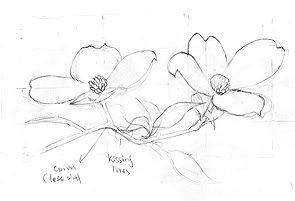 |
often of unidentifiable flora and foliage,
popular at Kravitz, a New York Design
Center showroom.
I attended the Ontario College of Art and Design's graduating students' exhibition this weekend. I was surprised to see a reasonably solid piece of textile work that was featured in the "Fabrics" section. In the past years, fabric work has been the weak link at OCAD. The jewelry students were often the stars - they still are. In this year's work, the fabric student had prepared a bedroom ensemble of a quilt and throw pillows, with flowers printed on satiny material. The work was well thought out, and well designed. It looked professional.
But, something bothered me when I returned home after my quick first visit. I thought it had to do with the overly simplistic, yet cleverly executed, idea. It felt shallow to me. I went a second day to analyze it further. This is my field after all, and I'm trying to find allies.
Looking carefully a second time, these are the weaknesses I found - and I say this with a positive spirit. I don't think her teachers would make these assessments, since I've found that home decor is the least of their interests; they're more into the "art" of it all.
- Although the flower print was supposed to depict a lilac, it resembled a foxglove much more. Now, what this student did was to work with an elongated form stretching the flower upwards. But a lilac doesn't stretch up, it spreads outwards. Also, her rendition didn't show the clusters of flowers that are part of a lilac's structure. This inaccurate depiction affected the whole concept of the design making it long instead of wide.
- There were no leaves in the design. All good floral works incorporate leaves in their patterns, adding an extra dimension and complexity to the design.
- There were no secondary colors within the flower. All the student did was to print different colors of the same (foxglove) shape. Often, good floral patterns have some aspects of dark and light shades (dark purple for shadows, light purple for highlights, etc.), giving a fullness to the shape.
- There were no variations in size. The flower was the same size throughout. This, once again limits the complexity of the work.
- What became clear as I looked at this deceptively simple work was the ways in which the student used just one pattern, of one flower (same size and shape) to accomplish her successful work. Good design work often incorporates a minor (secondary) shape, even if it is a smaller version of the original. Even animals and birds could be added as these secondary elements. This once again gives complexity and interest to the work.
- Finally, as I looked through her workbook - which was available at the exhibition - I noticed right away that she couldn't draw.
That was it, I thought! That was what made me come back a second day to figure out what I found wanting in this strangely accomplished work.
Firstly, without drawing ability, it is hard to capture the true nature of an object, unless one resorts to photocopying - which is problematic in many ways. I will go into it later, perhaps, but one of the problems is that photocopying doesn't allow one to experiment with the many dimensions of the size, direction, angle etc. of the shape.
Drawing also allows for study of details, like leaf structure, direction of veins, color variation, petal shape, relationship of the different parts, and so on. Studying these elements helps give even more authenticity to the design.
Another thing I realized was that her list of influences was a total of two names. Whoever heard of a two-name reference in a student's thesis! And both of these influences are minimalist designers, who are now the rage all over the design world. One is Clarissa Hulse, and her silhouettes of leaves and plants. The other is the Finnish Sari Syväluoma, who brings a cartoon-like element into her designs. Neither of these designers seems to be concerned with representing true plants and flowers, but rather creates her half imaginary world instead. Granted these designers never design totally in the abstract, but they never fully (accurately) depict nature and other objects, either. Now, I am beginning to wonder if it is a problem with basics, i.e. a problem with drawing!
"Ah, that is why they let her do her thesis," was my thought. After all, all kinds of famous names are cropping up (such as Allegra Hicks) who are promoting this minimalist style. Who wants those passé William Morris and Charles Voysey as influences!
At one point, designers were accomplished drawers (or illustrators). That is why I spent a good two years studying that skill after I finished my textile courses. I learned to respect accurate rendition, and its infinite possibilities on the imagination.
What contemporary designers have opted for, including students, is a half-imagined, over-simplified and often inaccurate depiction of the world around them.
Imagine having pillows on your couch where you are not really sure what the prints are. Are they foxgloves or lilacs? Is it a rose or a rock? Imagine, a rose passing as a rock. I have been confronted thus.
Although I was pleasantly surprised to find a student who had clearly put hours of work into her design, I couldn't help but feel sorry for her. If she at least had had the basics of drawing, she would have managed a truly beautiful piece. She is clearly talented.
From the pink flowering dogwood project:
 |
 |
 |